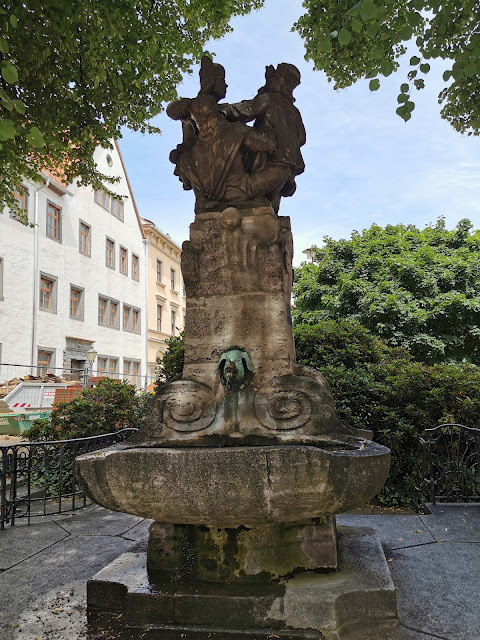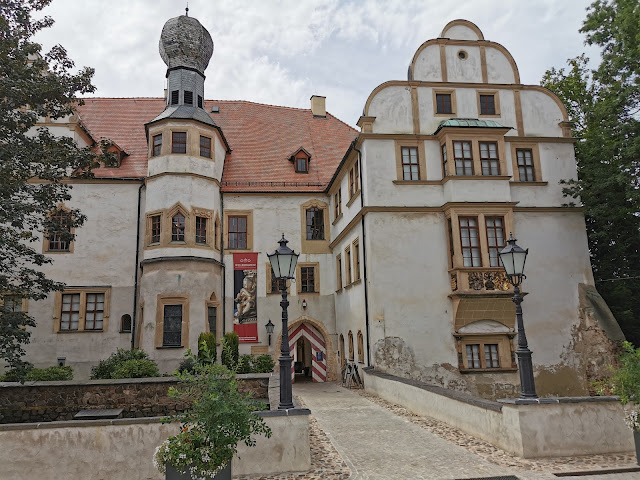On a nice weekend, I decided to do a long trip, heading south of Berlin. I left very early and after a few changes reached the first stop of the day, the town of Altenburg. The city has a long history, having been first mentioned in 976. It grew throughout the Middle Ages, even being often visited by Frederick Barbarossa during the 12th century. Industrialization reached Altenburg and the region quite early in the first half of the 19th century, becoming also the first city in Thuringia to be connected to the railway in 1842. Economic malaise set in while Altenburg was in East Germany and continued after German reunification in 1990, evidenced by the population which is nearly half what it was fifty years ago. I immediately saw signs of its past grandeur once I exited the train station and headed towards the old town. The suburb in fact held beautiful 19th and early 20th century Gründerzeit style villas, many of which are now badly unkempt. Not too far on I then reached a large park. I headed uphill through it, passing by the Lindenau-Museum housed inside an 1876 building, but unfortunately closed due to restructuring. At the top of the park, I passed by the Orangerie and finally reached the town's main highlight the castle. Before heading inside though I decided to see the old town. I headed downhill and walked through town, first reaching St. Mary's Monastery, a former monastery on a hill in the eastern part of town. It was founded during the 12th century and abandoned in 1543, with only the two Romanesque towers and some walls remaining. Not too far from it another, tower, the Kunstturm, built in the mid 19th century in the style of an Italian campanile, and used as a water tower until 1878. Heading then through the old town I reached the church of St. Nicholas, first mentioned in 1140 but eventually demolished during the 16th century. Only its steeple remains, refurbished and painting its baroque early 17th century appearance. From there I then reached the Markt, the main square, surrounded by nice old buildings. A small food fair with a stage and band playing was set up in the middle. On the southern side of the square stands the town hall, built between 1562 and 1564 and considered one of the most important Renaissance buildings in Germany. Moving onwards I then reached and entered St. Bartholomew's Church, built between 1428 and 1443 in Gothic style over a pre-existing Romanesque church. It once also featured two towers, the first collapsed in 1659 and the other was demolished after and replaced by a single baroque tower in 1668. Next door was the Brühl, the oldest square in town, a small space surrounded by nice buildings. At its southern end is a fountain known as the Skatbrunnen, built to honor Skat, a three-player trick-taking card game of the ace-ten family, devised around 1810 in Altenburg and considered the national card game of Germany alongside Doppelkopf. Many skat players come to the fountain to baptize their cards in the water, which is said to bring luck to the player. Right next to the fountain another impressive sight, the 18th-century baroque Seckendorffsches Palais. Finally, after the round of the town I was back at the castle, a huge ducal residence located on a hill above the city center. It was in use first as a fortification and later as a residence from the 9th century until the end of the monarchy in Germany in 1918. Today's castle is a mix of styles, with parts still from the Gothic period, while many buildings and the interior are of 17th and 18th-century periods. After entering the large courtyard through the main southern gate I then walked to the western end where the baroque palace part is set. Here I bought the entry ticket and started touring the many rooms. The lower floor was dedicated to an exhibition on playing cards including the popular Skat game invented in Altenburg. Here was also the original fountain which I had previously seen as a copy in the Brühl square. On the upper floor, I then visited some more rooms, including the large and beautifully decorated ballroom which can only be visited during a guided tour and I was lucky enough to sneak in while a tour group was ending its visit. Throughout the rest of the rooms, including the so-called Empire and Alexandra Rooms, designed for Duke Frederick III and his wife, I saw exhibits on weaponry, porcelain, and sacred art as well as a watch collection. Also nice was the library built at the beginning of the 20th century. After the tour of the upper floors, I headed to the ground floor where a section presented an exhibition on the Schlöben hoard, a collection of gold jewelry and objects found nearby from the bronze age. Once outside the building, I passed by the nice Gothic castle church, unfortunately only visitable through a tour, and then walked past the other building surrounding the central courtyard to reach the Hausmannsturm. Built in the 12th century, it is one of two surviving towers of the original seven towers of the castle. At 32 meters, it is the tallest structure in the castle complex. Once at the top, I had a great view of the complex as well as part of the city and the surrounding landscape. Once back down the tower I exited the castle and headed on to reach the train station where I took the next ride to the town of Glauchau. Once there I got off the train and then walked through the city center. I passed through the small old town with some nice preserved 19th-century buildings and past the main square, the Markt. Not long after I walked by the baroque church of St George, which was unfortunately closed, and then reached the town's main monument, Schloss Glauchau. This large castle complex consists of actually two castles, the Hinterglauchau Castle and the Forderglauchau Castle. The former was built between 1170 and 1180. and then converted into a late Gothic structure between 1470 and 1485. The latter was then added from 1527 to 1534 and is considered the earliest Renaissance building in Central Germany. During the same period, the Hinterglauchau part was then rebuilt in the Renaissance style, kind of uniforming the whole complex. As I entered the courtyard I headed to the rear part where the museum is located. As I entered the building I admired the beautiful Renaissance style still showing some gothic features. After paying for the entry ticket, once inside I toured the rooms, starting out with the nice late 19th-century wooden dining room. A stair led to the upper rooms where some nice realist paintings from the 19th and 20th centuries were exhibited. Moving on I reached the core of the Renaissance building, here was the part of the castle facing the courtyard with a gothic bay window, an original Renaissance painted wooden ceiling, and the historical rooms. These were furnished in different styles ranging from the rococo, through the neoclassical, and later romantic periods. Once I had visited the museum, I came back out and the lady at the ticket office led me to the castle church, which she opened up for me. This is one of the few gothic features still left of the complex. Inside were some religious art pieces including some nice gothic statues and altarpieces. After the visit, it was time to head on. I left the castle complex behind and walking through the old town once more reached the train station. After switching once I then reached the last stop of the day, the city of Zwickau. Once there I headed toward the city center and as I approached the old town some streets were under construction. I reached then the church of St Mary, the town's cathedral, a beautiful 15th and 16th century late gothic building. It features a tall 87m high spire. Unfortunately, as I found out, the church was closed, despite being afternoon, and it usually is on Sundays, Mondays, and Tuesdays with the addition of needing an entry fee. This was quite comical and insane so I just accepted to having to admire it only from the exterior. In front of the church, were the so-called Priesterhäuser, four buildings with steep Gothic gables, which are among the oldest residential buildings in Germany and now turned into a museum. From there I continued on through town and reached the Hauptmarkt, the main square. At its southwestern part was the house where Robert Schumann was born in 1810, while at its southern part was the town hall, built in 1404 but rebuilt in the 19th century. Next to the town hall another landmark, the Gewandhaus, the former clothmakers' trading house built in 1522-1525 in late Gothic style, with Renaissance elements and stepped gables. The square overall was quite nice and lively, with the northern and eastern parts filled with cafes and restaurants already packed with people having a drink or snack or others even starting their dinner. Continuing on throughout town I reached the northern part of town where the church of St Catherine is set. It was built in the 15th century in a Gothic style but was unfortunately closed as well when I was there. Not far from it was the Schloss Osterstein, built as an electoral palace complex in the late 16th century and completely rebuilt in the early 2000s as it was in full ruins. It was then time to go, I walked through the rest of the old town and once more through the main square before eventually reaching the train station and taking the next ride back to Berlin.
 |
| One of the gates to the Altenburg castle |
 |
| The towers of St. Mary's Monastery |
 |
| The Kunstturm |
 |
| The tower of St Nicholas' church |
 |
| The renaissance town hall |
 |
| The main square |
 |
| The church of St Bartholomew |
 |
| A street in the old town |
 |
| The Skatbrunneb |
 |
| A view of the castle |
 |
| The large ballroom |
 |
| One of the castle rooms |
 |
| The Flasche tower |
 |
| View of the castle and city from the Hausmannsturm |
 |
| Glauchau's main square |
 |
| One of the rooms of Schloss Glauchau |
 |
| The castle's main courtyard |
 |
| The inner courtyard |
 |
| Exterior view of the castle |
 |
| A street in the old town |
 |
| The Zwickau cathedral |
 |
| The main square and Gewandhaus |
 |
| A street in the old town |























No comments:
Post a Comment